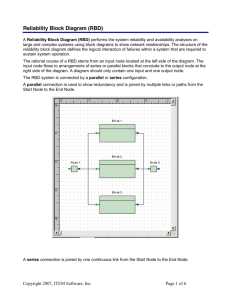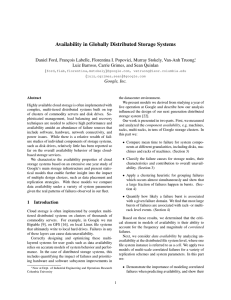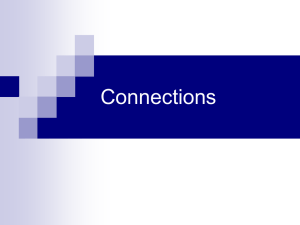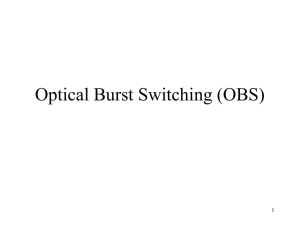pptx
advertisement
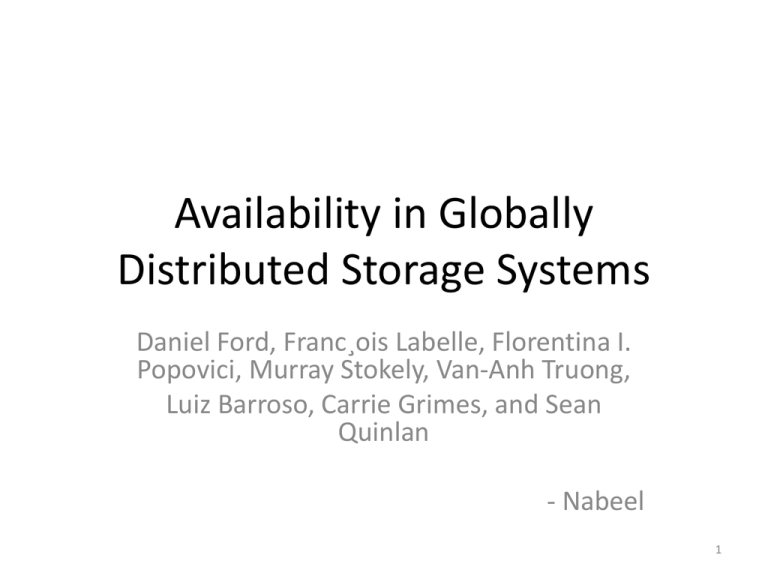
Availability in Globally Distributed Storage Systems Daniel Ford, Franc¸ois Labelle, Florentina I. Popovici, Murray Stokely, Van-Anh Truong, Luiz Barroso, Carrie Grimes, and Sean Quinlan - Nabeel 1 Distributed Storage System • • • • • Exponential increase in storage needs Uses shared nothing architecture Uses low commodity hardware Software layer provides fault tolerance Suitable for data parallel, I/O bound computations • Highly scalable and cost effective 2 Data Center 3 Data Center Components Server Components Racks Interconnects Cluster of Racks 4 Data Center Components Components ALLServer THESE COMPONENTS CAN FAIL Interconnects Racks Cluster of Racks 5 Google File System 6 Cell, Stripe and Chunk GFS Instance 1 GFS Instance 2 Chunks Chunks Chunks Chunks Stripe 1 Stripe 2 Stripe 1 Stripe 2 CELL 1 CELL 2 7 Failure Sources and Events • Failure Sources – Hardware – Disks, Memory etc. – Software – chunk server process – Network Interconnect – Power Distribution Unit • Failure Events – Node restart – Planned reboot – Unplanned reboot 8 Fault Tolerance Mechanisms • Replication (R = n) – ‘n’ identical chunks (replication factor) are placed across storage nodes in different rack/cell/DC • Erasure Coding ( RS (n, m)) – ‘n’ distinct data blocks and ‘m’ code blocks – Can recover utmost ‘m’ blocks from the remaining ‘n-m’ blocks 9 Replication 5 replicas 1 Chunk Fast Encoding / Decoding Very Space Inefficient 10 Erasure Coding ‘n’ data blocks ‘m’ code blocks Encode ‘n + m’ blocks 11 Erasure Coding ‘n’ data blocks ‘m’ code blocks Encode ‘n + m’ blocks 12 Erasure Coding ‘n’ data blocks ‘m’ code blocks Encode ‘n’ data blocks ‘n + m’ blocks Decode Highly Space Efficient Slow Encoding / Decoding 13 Goal of the Paper • Characterizes the availability properties of cloud storage systems • Suggests a good availability model that helps in data placement and replication strategies 14 Agenda • • • • • Introduction Findings from the fleet Correlated failures Modeling availability data Conclusion 15 CDF of Node Unavailability 16 CDF of Node Unavailability 17 Average Availability and MTTF • Average availability of ‘N’ nodes AN = ----------------------------- • Mean Time To Failure (MTTF) uptime Uptime MTTF = -------------------No. of failures downtime Failure 1 Failure 2 18 CDF of Node Unavailability by Cause 19 Node Unavailability 20 Correlated Failures • Failure Domain – Set of machines that simultaneously fails from a common source of failure • Failure Burst – Sequence of node failures each occurring within a time window ‘w’ of the next – 37% of all failures are part of a burst of at-least 2 nodes 21 Failure Burst 22 Failure Burst 23 Failure Burst 24 Failure Burst (cont..) 25 Failure Burst (cont..) 26 Failure Burst (cont..) 27 Failure Burst (cont..) 28 Failure Burst (cont..) 29 Domain Related Failures • Domain related issues – causes of correlated failures • A metric is devised – To determine if a failure burst is domain related or random – In evaluating the importance of domain diversity in cell design and data placement 30 Rack Affinity • Probability that a burst of the same size affecting randomly chosen nodes have smaller affinity score • Rack Affinity Score – Determines the rack concentration of the burst – No. of ways of choosing 2 nodes from the burst within the same rack where ki is the no. of nodes affected in the ith rack affected. Eg. (1,4) and (1,1,1,2) 31 Stripe MTTF Vs Burst Size 32 Stripe MTTF Vs Burst Size 33 Stripe MTTF Vs Burst Size 34 Trace Simulation 35 Markov Model • To model & understand the impact of hardware and software changes in availability • Focused on the availability of a stripe – State : No. of available chunks (in the stripe) – Transition : Rates by which a stripe moves to the next state due to: • Chunk Failure ( reduces available chunks) • Chunk Recoveries ( increases available chunks) 36 Markov Chain 37 Markov Model Findings • RS (6,3) – No correlated failures • 10% reduction in recovery time results in 19% reduction in unavailability – Correlated failures • Reduced MTTF when correlated failures are modeled • 90% reduction in recovery time results in 6% reduction in unavailability • Reduces the benefit of increased data redundancy 38 Markov Model Findings (cont..) 39 Markov Model Findings (cont..) • R = 3 and increase in availability – 10% reduction in disk latency error has negative effect ??? – 10% reduction in disk failure rate has 1.5% improvement – 10% reduction in node failure rate has 18% improvement • Improvements below the node layer of the storage stack do not significantly improve data availability 40 Single Cell Vs Multi-Cell • Trade off between availability & inter cell recovery bandwidth. Higher MTTF with Multicell replication. 41 Single Cell Vs Multi Cell (cont..) R1 R2 CELL A R3 R4 Single Cell R1 R3 CELL A CELL B R2 R4 Multi Cell 42 Conclusion • Correlation among node failures is important • Correlated failures share common failure domains • Most unavailability periods are transient and differs significantly by cause • Reduce reboot times for kernel upgrades • The findings provides a feedback for improving – Replication and encoding schemes – Data placement strategies – Primary causes of data unavailability 43 44
